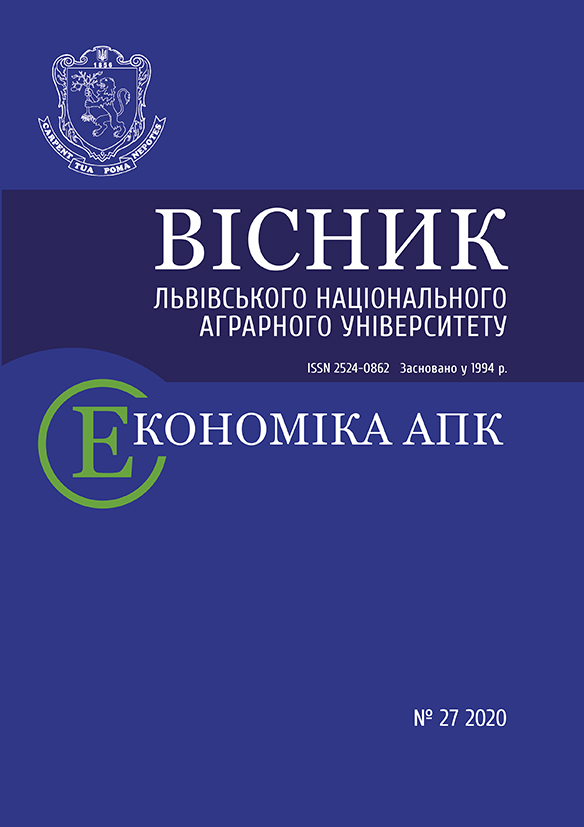Visnyk LNAU: Agronomy 2020 №24: 123-127
Indices of productivity components of the collectible samples of durum and bread spring wheat and their relations with yield
S. Khomenko, Doctor of Agricultural Sciences
ORCID ID: 0000-0002-6047-7711
T. Chuhunkova, Doctor of Biological Sciences
ORCID ID: 0000-0002-8945-0854
I. Fedorenko, Candidate of Agriultural Sciences
ORCID ID: 0000-0001-5471-6475
M. Fedorenko, Candidate of Agricultural Sciences
ORCID ID: 0000-0002-3021-3643
Ye. Kuzmenko
ORCID ID: 0000-0002-6256-1482
V. M. Remeslo Myronivka Institute of Wheat of NAAS of Ukraine
https://doi.org/10.31734/agronomy2020.01.123
Annotation
The research analyzes productivity components and determines their correlations with yield of the collectible samples of bread and durum spring wheat. The article presents results of the 5-year study (2012–2016) of the indices of main spike length, grain number in the main spike, grain weight in the main spike, and weight of 1000 grains in the collectible samples of spring wheat, which are studied at the V. M. Remeslo Myronivka Institute of Wheat of NAAS of Ukraine. The researchers selected samples from different countries of the world, which had the best parameters among the analyzed productivity components and could be used as promising sources of traits when carrying out crosses. The variety Manu (FIN) was specified among the others because of its characteristics, i.e. its spike length exceeded 10 cm, similar to the samples, including Ukrainian ones, which had spikes from 9.2 to 9.7 cm long. The researchers distinguished the samples of bread spring wheat with more than 40 grain in the main spike, grain weight in the main spike up to 1.7 g. The weight of 1000 grains was at the standard level. Among the durum spring wheat samples, the varieties of Ukrainian breeding, namely Daryna and Zhadana, were characterized by the longest spike. The indices of other productivity components were mostly at the standard level over the years of the research. The highest figures were observed in 2014. The year supplied favorable weather conditions for growth and development of spring wheat plants. The correlations between productivity components of bread and durum spring wheat were different. Strong relationship was established between the yield of collectible samples of spring durum wheat and grain number in the main spike (r = 0.77). Most of other correlations were weak or moderate. Thus, according to the indices of productivity components in collectible samples, the researchers identified the sources, which can be used as source material for creating of high-performance varieties. The correlation analysis showed the most effective ways of selection referring to the productivity elements in bread and durum spring wheat to get a high level of yield.Key words
bread and durum spring wheat, collectible samples, productivity components, yield, correlations
Link
- Chekalin N. M., Tyshchenko V. N., Ziukov M. E. Simple and partial coefficients of genetic correlation between crop yield and the traits of spike productivity in the lines and varieties of winter wheat. Collected Scientific Works of the Plant Breeding and Genetics Institute – National Center of Seed and Cultivar Investigation of UAAS. 2004. Vol. 6. P. 103–110. [in Russian]
- Craven L. M., Carter P. R. Seed size shape and tillage system effect on corn growth and grain yield. J. Product. Agr. 1991. Vol. 3 (4). Р. 445–452. https://doi.org/10.2134/jpa1990.0445
- Dolgalev M. P., Kriuchkov A. G. The dependence of yield of bread spring wheat varieties on agronomic and biological traits. Bulletin of Orenburg State University. 2003. № 1. P. 74–79. [in Russian]
- Dospekhov B. A. Methods of the Field Experiments. Moscow: Agropromizdat, 1985. 351 p [in Russian]
- Fomenko M. A. The main markers in breeding for productivity index in the steppes of the Rostov region. Genetics and Plant Breeding on the Don. 2003. Vol. 3. P. 36–47. [in Russian]
- Holik V. S., Holik O. V. Results of spring wheat and durum wheat breeding research. Breeding field crops. Kharkiv: [n.p.] 2008. P. 126–150. [in Ukrainian]
- Kalenska S. M., Zhuravliova N. V, Maksymenko O. A., Maleonchuk, O. V. Spring wheat in grain area structure. Collection of Scientific Works of the National Scientific Center «Institute of Agriculture of NAAS». 2005. Vol. 3. P. 64–69. [in Ukrainian]
- Lykhochvor V. V. Ways to improve winter wheat grain quality in the Forest-Steppe conditions of western Ukraine. Journal of Lviv State Agrarian University: agronomy. 2001. № 5. P. 170–177. [in Ukrainian]
- Orliuk A. P., Honcharova K. V. Wheat Adaptive and Productive Potential. Kherson: Ailant, 2002. 276 p. [in Ukrainian]
- Rusanov I. A., Bukhovetskiy A. G. Breeding assessment of winter wheat by rank correlation. Proceedings of Voronezh State University. 2010. № 43. P. 15–20. [in Russian]
- Tyshchenko V. N. The duration of growing season and interphase periods and their correlation with productivity depending on the conditions of the year and the genotype of winter common wheat. Bulletin of Poltava State Agrarian Academy. 2005. № 3. P. 97–102. [in Russian]
- Vasylkivskyi S. P., Kochmarskyi V. S. Seed Growing of Winter Wheat. Myronivka: [n.p.], 2016. 376 p. [in Ukrainian]



